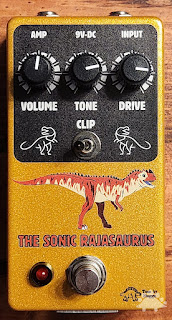For this build I'm using a PCB laid out by my friend in Ukraine, South Obolon FX. He obviously had a bit of fun with the placement of the rather unique diodes called for in this build. By and large most of the parts needed for the Prince of Tone are normal resistors and capacitors, and an fairly easy to get op amp. However, like the King of Tone, the original uses somewhat unusual clipping diodes. In this case the four MA856 or equivalent. I'm using MA858 diodes for this build, but those are getting hard to find. I have a small stock, but I'm being careful how I use them.
Of course, that brings up the great debate about diodes in the King of Tone / Prince of Tone circuit. Some people swear they are absolutely what is needed, others can't hear the difference when using diodes with other specs. I suspect the impact will vary with guitar, amplifier, and other pedals in the chain. That being said, AionFX goes into the differences on their site. The original MA856 diodes do clip at a higher threshold than most common silicon diodes like the 1N914 (0.82V vs 0.7V). There are some substitutes out there which match the performance of the MA856 across a fairly wide current range, but most of those are also either out of production or have reached end of life and will soon be out of production.
The Prince of Tone also has several internal controls. There is a presence trimmer which adds additional treble (much like many Marshall amps). If it's cranked you can get more hiss as well. There is also a mids switch which boosts the low-mid frequencies. There is also a "turbo" switch which increases the total gain on tap. By and large I'm not a huge fan of internal controls, so I may lay out a version of this that brings all of the knobs and switches to the face of enclosure.
As for the rest of the build, I'm using my normal Switchcraft jacks and Lumberg DC jack. All of the jack connections are insulated with heat shrink tubing, and the hook-up wiring is all aviation grade. For this one, I decided to go ahead and enable the brightness control on the LED since this pedal had a few internal controls already.
For the dinosaur mascot, I decided to play with the "prince" part of the name of the original pedal, though there is some disagreement whether "Rajasaurus" translates best as "prince lizard" or "king lizard." That being said, according to Wikipedia:
"Rajasaurus is a genus of carnivorous abelisaurid theropod dinosaur from the Late Cretaceous of India, containing one species: Rajasaurus narmadensis. The bones were excavated from the Lameta Formation in the Gujarat state of Western India, probably inhabiting what is now the Narmada River Valley. It was formally described by palaeontologist Jeffrey A. Wilson and colleagues in 2003 based on a partial skeleton comprising the braincase, spine, hip bone, legs, and tail–a first for an Indian theropod. The dinosaur likely measured 6.6 metres (22 ft), and had a single horn on the forehead which was probably used for display and head-butting. Like other abelisaurids, Rajasaurus was probably an ambush predator."
The pedal sounds great based on the demos I've seen online, but as I mentioned, I'm typically not as big a fan of internal controls. I know that these are all accurate to the original, but given how roomy the circuit is in the 125B enclosure, I am really considering an alternate layout with 4 knobs and 3 switches. Of course, that may have the opposite problem of too many controls up top, and then there's the problem of diode scarcity.






No comments:
Post a Comment